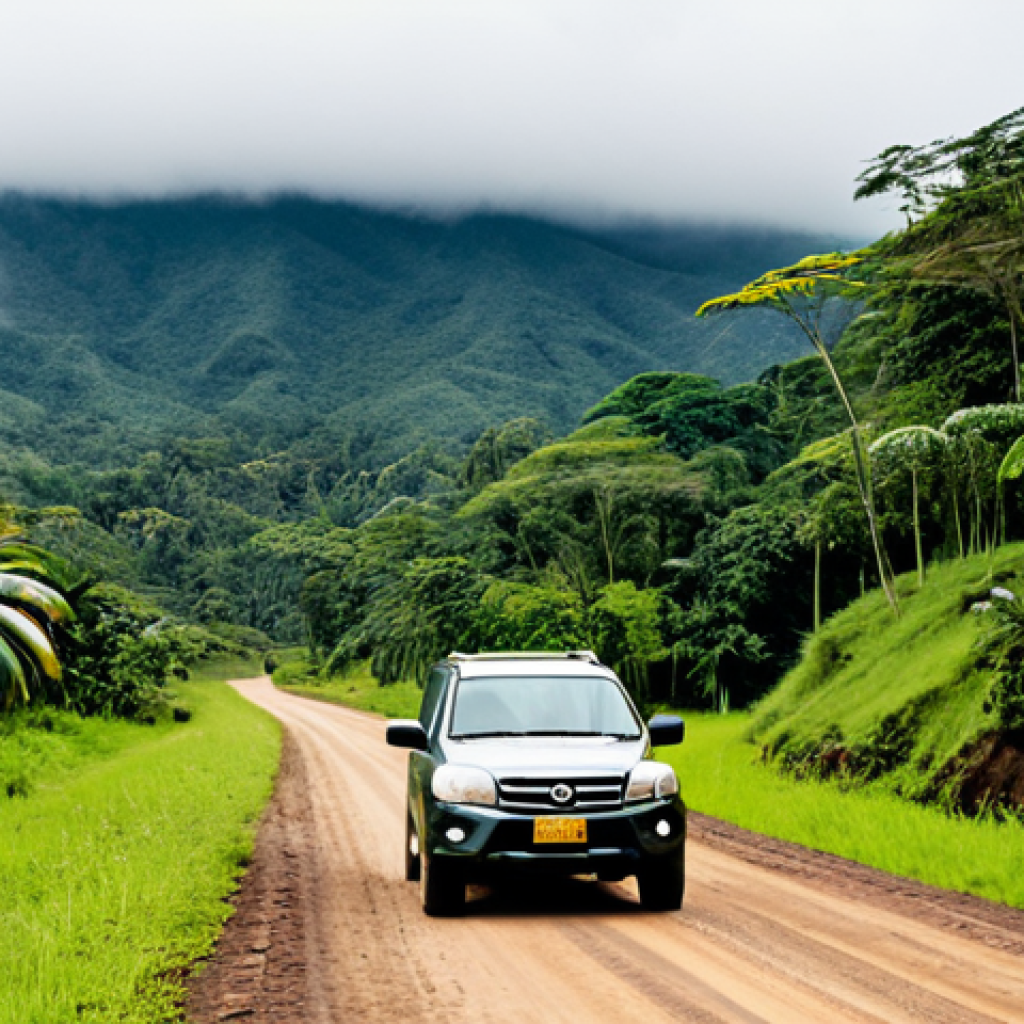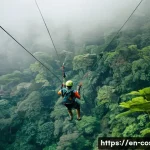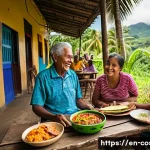There’s a unique thrill that washes over you the moment your wheels hit the pavement in Costa Rica, a kind of ‘Pura Vida’ invitation to explore. I still vividly remember the first time I wound my way through the lush Talamanca mountains, feeling every curve and dip as the vibrant landscape unfolded before me – it wasn’t just a drive, it was an immersion, a sensory feast.
This isn’t your average highway cruise; it’s an adventure where every turn reveals a new, breathtaking vista or a hidden waterfall, a testament to why more and more travelers, especially those seeking authentic, sustainable experiences, are choosing the freedom of four wheels to truly connect with this incredible country.
From vibrant coastal stretches where surfers chase the perfect wave to misty cloud forests teeming with elusive wildlife, Costa Rica’s diverse road trip routes are rapidly becoming legendary.
It’s truly a journey for the senses, and believe me, you’ll want to capture every unforgettable moment. Ready to uncover the real magic? Let’s dive deep into the details below.
The Unspoken Language of Costa Rican Roads

Driving in Costa Rica isn’t merely about getting from point A to point B; it’s an immersive experience, a living, breathing part of your adventure that constantly challenges and delights.
I distinctly recall my initial moments behind the wheel here, a mixture of exhilaration and slight trepidation as I navigated what felt like an entirely new set of rules – or perhaps, the delightful absence of rigid ones.
The roads themselves tell a story, winding through landscapes that shift from sun-drenched beaches to dense, misty cloud forests in what feels like mere minutes.
You quickly learn to anticipate the unexpected: a lazy sloth crossing the road, a sudden downpour that transforms a dirt track into a mud slide, or simply the breathtaking view around a blind curve.
It’s a dance with nature and local rhythm, demanding your full presence and rewarding you with unparalleled freedom. This isn’t just about the physical act of driving; it’s about connecting with the very pulse of the country.
1. Decoding the Pura Vida Driving Style
From my very first day, it quickly became clear that the concept of “Pura Vida” extends far beyond just a greeting; it’s a philosophy that permeates every aspect of life, including the way people navigate the roads.
I noticed an almost unwritten code of courtesy and patience, a refreshing contrast to the hurried pace of driving in many other parts of the world. Honking, for instance, isn’t typically an aggressive gesture; it’s often a friendly warning or a quick thank you.
Locals often give way with a casual wave, and you’ll find an unspoken understanding between drivers about sharing narrow bridges or unpaved sections. What I initially perceived as chaos slowly transformed into a harmonious flow, a shared understanding that everyone is on their own journey, and a little kindness goes a long way.
This includes navigating around livestock that might occasionally meander onto the road or pausing for pedestrians. It’s less about strict adherence to rules and more about adaptive awareness and mutual respect, which, once you embrace it, makes the entire driving experience infinitely more enjoyable and authentic.
2. Mastering the Terrain: From Paved Paths to ‘Unpaved Adventures’
The sheer diversity of Costa Rica’s topography means that your driving experience will be anything but monotonous. One moment you might be cruising on a smooth, modern highway, only to find yourself minutes later on a gravel track winding through a remote village, or even crossing a small river ford.
I still chuckle recalling the time my GPS confidently instructed me to turn onto what looked like an animal trail – turns out, it *was* the road! This is where the real adventure often begins.
Having a vehicle capable of handling various conditions becomes paramount, especially if you plan to venture beyond the major tourist hubs. The unpaved roads, while sometimes challenging, are often your gateway to some of the country’s most pristine natural wonders and hidden gems that bus tours simply cannot reach.
This requires a certain level of adaptability and an understanding that your average speed might be much lower than you’re used to, but the scenic rewards are immeasurable.
It’s about accepting the journey, dust and all, as part of the destination.
Beyond the Tourist Trail: Discovering Authentic Local Flavors
One of the most profound joys of a Costa Rican road trip, for me, was the freedom to deviate from the well-trodden paths and stumble upon the true essence of the country.
It’s in these unplanned detours that you truly connect with the heart and soul of Costa Rica, far removed from the polished facades of resort towns. I remember vividly pulling off a main road on a whim, following a tiny sign that promised “cascada,” only to discover a secluded waterfall where local children were joyfully splashing, entirely oblivious to tourists.
This kind of spontaneous exploration allows for genuine interaction with local culture, a chance to witness daily life unfold organically, and to appreciate the subtle nuances that make each region unique.
It’s about letting curiosity guide you and embracing the unexpected, transforming a simple drive into a rich tapestry of cultural discovery and personal connection.
This is where the real stories are born, the ones you’ll recount for years to come.
1. Savoring Local Delights: From Sodas to Street Food
My taste buds still tingle recalling the explosion of flavors found in Costa Rica’s local eateries, particularly the charming “sodas” dotting the roadside.
These aren’t just restaurants; they’re culinary institutions, often family-run, serving up authentic, soul-satisfying meals at incredibly affordable prices.
I made it a personal mission to stop at every brightly painted soda that caught my eye, always ordering the “casado” – a generous plate featuring rice, beans, plantains, salad, and your choice of meat or fish.
Each one offered a subtly different, yet consistently delicious, take on the national dish, reflecting regional variations and grandmother’s secret recipes.
Beyond sodas, the roadside fruit stands were another treasure. The sheer vibrancy of fresh mangoes, papayas, and guanábanas was irresistible. My morning ritual often involved pulling over for a freshly prepared fruit smoothie, or “batido,” made right before my eyes.
This deep dive into local cuisine wasn’t just about sustenance; it was an integral part of understanding the local culture and economy, supporting small businesses directly.
2. Engaging with Local Communities: More Than Just a Stop
One of the most rewarding aspects of having my own vehicle was the ability to spend unhurried time in small towns and villages that larger tour groups often bypass.
I found myself engaging in conversations with local artisans selling their crafts by the roadside, exchanging smiles with farmers tending their fields, and even joining in a spontaneous game of soccer with some kids in a dusty town square.
These interactions, however brief, were incredibly enriching. I learned about local traditions, gained insights into conservation efforts, and felt a profound sense of connection to the people and the land.
Unlike the rushed stops of organized tours, having your own car allows you the luxury of simply *being* there, observing, and participating in the rhythm of local life.
It’s in these moments, perhaps buying a handmade souvenir directly from the artist or sipping a coffee brewed in a tiny, independent cafe, that you realize the true value of your road trip: it’s not just about seeing the sights, but about experiencing the soul of Costa Rica through its people.
Essential Preparations for a Seamless Journey
Embarking on a Costa Rican road trip demands a bit more forethought than your average drive, but the payoff in terms of freedom and adventure is absolutely worth it.
My first attempt at planning involved a fair bit of trial and error, learning quickly that what works in other countries doesn’t always apply here. From understanding the nuances of vehicle rentals to packing essentials that cater to a wildly diverse climate, preparation is truly key to unlocking the full potential of your journey.
I realized that a well-prepared traveler isn’t just comfortable; they’re empowered to truly embrace the spontaneity and unexpected magic that Costa Rica offers.
It’s about setting yourself up for success, minimizing potential headaches, and maximizing the sheer joy of discovery.
1. Navigating Rental Realities: Choosing Your Trusty Steed
Choosing the right vehicle for your Costa Rican adventure is arguably the most crucial decision you’ll make. Based on my own experience, simply showing up and hoping for the best is a recipe for stress.
I initially thought a compact sedan would be fine, only to quickly realize how limiting it was on anything but the main highways. The country’s varied terrain, from smooth coastal roads to rugged mountain passes and sometimes unpaved rural tracks, truly calls for a robust vehicle.
For many of the hidden gems and off-the-beaten-path experiences I sought, a 4×4 was not just recommended but absolutely essential. Remember to factor in not just the daily rental rate, but also mandatory insurance, which can often double the cost – a detail that caught me by surprise initially.
Always book well in advance, especially during peak seasons, and meticulously inspect the vehicle before you drive off the lot. Take photos of any pre-existing damage, however minor, to avoid disputes later.
Here’s a quick overview of vehicle types and their suitability:
| Vehicle Type | Pros | Cons | Ideal For |
|---|---|---|---|
| Compact Sedan | Fuel efficient, good for paved highways, cheaper rental. | Limited ground clearance, struggles on unpaved roads, not suitable for remote areas. | City exploration, coastal towns with paved access (e.g., Manuel Antonio, Jacó). |
| Small SUV (2WD) | Better ground clearance than sedan, more comfortable. | Still limited on very rough or muddy roads, not true 4×4 capabilities. | Main tourist routes, slightly off-paved roads, some national park access. |
| Mid-size SUV (4×4) | Excellent ground clearance, handles most terrains (dirt, gravel, minor rivers), versatile. | Higher fuel consumption, more expensive rental, may feel large in small towns. | Exploring remote areas (e.g., Osa Peninsula, Monteverde’s cloud forest roads), wet season travel. |
| Large SUV / Truck (4×4) | Maximum off-road capability, spacious for gear/passengers. | Highest fuel consumption, most expensive rental, can be challenging to park. | Serious off-roading adventures, large groups, carrying extensive gear. |
2. Packing Smart: Gear for Every Microclimate
Packing for a Costa Rican road trip felt like preparing for several different trips all at once, given the country’s incredible microclimates. One moment you’re sweating in the humid heat of the Caribbean coast, the next you’re shivering in the misty coolness of a cloud forest, and then drying out in the sun-drenched Guanacaste plains.
My advice, honed from personal experience, is to embrace layers and versatility. Lightweight, quick-drying clothing is your best friend, as are a good rain jacket (even in dry season, unexpected showers happen!) and a pair of sturdy, waterproof walking shoes or hiking boots.
Don’t forget swimwear for those impromptu dips in waterfalls or ocean waves. Essentials like high-SPF sunscreen, insect repellent (especially for evenings), a wide-brimmed hat, and a reusable water bottle are non-negotiable.
I also found a portable power bank and a good camera with extra batteries invaluable for capturing the endless beauty without worrying about running out of juice.
Packing smart means you’re always prepared for the next adventure, no matter what climate zone you find yourself in.
Embracing Spontaneity: The Best Route is Your Own
While guidebooks offer fantastic suggestions, the true magic of a Costa Rican road trip, in my opinion, lies in the freedom to deviate from the planned itinerary.
It’s about allowing yourself to be open to discovery, to follow a promising side road, or to linger longer in a place that simply captivates your soul.
I remember one afternoon, completely abandoning my schedule after a local recommended a small, unmarked trail leading to a hidden hot spring. It wasn’t on any map I owned, but following that local’s enthusiastic directions led me to one of the most serene and memorable experiences of my entire trip.
This spontaneity is precisely why I advocate for road tripping over organized tours; it’s the liberty to chart your own course, to chase sunsets on a whim, or to explore a vibrant local market because you heard the distant sounds of music.
It’s about creating *your* unique narrative, not just ticking off a list of attractions.
1. Off-the-Beaten-Path Wonders: Where Maps Don’t Reach
The most enchanting discoveries I made in Costa Rica were almost always in places that weren’t highlighted in tourist brochures or easily found on mainstream navigation apps.
These “off-the-beaten-path” wonders range from a humble roadside eatery serving the most incredible plantain empanadas, to a secluded beach where the only footprints were my own, to a tiny, family-run coffee farm where I learned about the entire bean-to-cup process firsthand.
What I’ve learned is that these hidden gems are often revealed through conversations with locals, a keen eye for subtle signs, or simply the courage to take a road less traveled.
They require a bit of adventurous spirit and a willingness to step outside your comfort zone, but the rewards are profound – authentic experiences, untouched natural beauty, and a deeper understanding of the country’s heart.
These are the moments that truly stick with you, long after the tan fades.
2. The Joy of the Detour: Unexpected Discoveries
There’s a unique kind of joy that comes from the unexpected, from the unplanned detour that blossoms into the highlight of your day. I’ve found that some of my most cherished memories from road trips in Costa Rica weren’t from arriving at a specific destination, but from the journey itself.
One time, I pulled over on the side of a mountain road just to admire a panoramic view, only to spend the next hour captivated by a troop of howler monkeys swinging through the trees right above me.
Another time, a flat tire led me to a small, incredibly friendly mechanics shop in a remote village, where I ended up sharing coffee and stories with the owner, learning more about local life than any guidebook could ever teach me.
These detours, whether forced or chosen, add a layer of richness and authenticity to your trip. They teach you resilience, patience, and the incredible beauty of serendipity.
So, embrace the detours, for they often lead to the most unforgettable adventures.
Safety and Savvy: Ensuring a Smooth Ride
While the allure of Costa Rica’s open road is undeniable, a truly enjoyable and stress-free journey hinges significantly on being prepared for the practicalities and potential challenges.
My personal experience has taught me that while “Pura Vida” is a wonderful life philosophy, it doesn’t always apply to road conditions or driving habits everywhere.
Understanding local customs, being aware of your surroundings, and taking sensible precautions are not about being paranoid; they are about being smart and ensuring your adventure remains truly joyful and memorable for all the right reasons.
It’s about empowering yourself with knowledge so that you can navigate any situation with confidence and ease, leaving you free to immerse yourself in the natural beauty and vibrant culture.
1. Understanding Local Driving Etiquette and Road Signs
Navigating Costa Rican roads involves more than just following the lines; it’s about understanding an unspoken language of gestures and subtle cues. From my perspective, one of the biggest initial adjustments was learning to interpret the local driving etiquette.
For example, a quick flash of headlights from an oncoming vehicle usually means there’s a hazard ahead – perhaps a pothole, a slow-moving vehicle, or even police.
Passing on solid lines is more common than you might expect, especially on winding mountain roads, so defensive driving is paramount. Road signs, while largely international in design, can sometimes be scarce or oddly placed, particularly in more rural areas.
Always pay attention to “CEDA” (Yield) and “ALTO” (Stop) signs. What truly surprised me was the sheer number of speed bumps (locally known as ‘reductores’ or ‘muelles’) in unexpected places, often unmarked, which can be quite jarring if you hit them at speed.
My advice is to always assume there’s something around the bend, drive at a reasonable pace, and rely on your instincts more than your speedometer.
2. Staying Safe: Tips for Navigating Any Situation
Staying safe on a Costa Rican road trip means being proactive and aware, rather than reactive. Firstly, never drive after dark if you can avoid it, especially on rural or unpaved roads.
Night driving brings increased risks due to poor lighting, unmarked obstacles, and the potential for livestock or pedestrians on the road. My personal rule of thumb became planning my drives to arrive at my destination well before sunset.
Secondly, always keep your car doors locked and windows up when in traffic or parked in urban areas. Petty theft, while not rampant, can occur. Never leave valuables visible in your car.
If you need to stop, choose well-lit, populated areas. Furthermore, have a charged cell phone and, ideally, a local SIM card with data for GPS and emergencies.
While emergency services are available, knowing a few basic Spanish phrases for directions or help can be incredibly useful. Finally, trust your gut feeling.
If a road looks questionable or a situation feels off, it’s always better to err on the side of caution and turn back or seek an alternative route. Your peace of mind is priceless.
Maximizing Your Experience: Budgeting and Beyond
A road trip in Costa Rica, while offering unparalleled freedom, can also be tailored to fit various budgets, from the adventurous backpacker to the comfort-seeking family.
My own budgeting strategy evolved throughout my travels, as I discovered countless ways to stretch my Colones further while still enjoying all the incredible experiences the country has to offer.
It’s not just about saving money; it’s about smart spending that enhances your journey, allowing you to immerse yourself more deeply in the local culture and contribute positively to the communities you visit.
Thinking beyond just the cost of gas and lodging can unlock unique opportunities and ensure your trip is not only memorable but also sustainable and responsible.
1. Smart Spending: Making Your Colones Go Further
One of the key lessons I learned about budgeting for a Costa Rican road trip is that local experiences often offer the best value. Eating at “sodas,” as mentioned earlier, is a fantastic way to save on food costs compared to tourist restaurants, and it provides a more authentic culinary experience.
Similarly, exploring farmers’ markets for fresh produce not only saves money but also allows you to interact directly with local vendors and savor incredibly fresh, seasonal fruits and vegetables.
When it comes to accommodation, mixing up your stays between charming boutique hotels, eco-lodges, and even small, family-run guesthouses can significantly impact your overall budget.
I also found that booking certain activities directly with local operators, rather than through large tour companies, often yielded better prices and ensured more of my money stayed within the local community.
It’s about being resourceful and embracing the local way of life.
2. Sustainable Travel: Treading Lightly on Paradise
Costa Rica is a global leader in ecotourism and conservation, and as a road tripper, I felt a deep responsibility to contribute to these efforts. Sustainable travel here isn’t just a buzzword; it’s a way of life that protects the country’s unparalleled biodiversity and supports its local communities.
This means actively minimizing your environmental footprint: carrying a reusable water bottle, avoiding single-use plastics, and disposing of waste responsibly.
I made a conscious effort to choose accommodations and tour operators that demonstrated clear commitments to sustainability, often indicated by the “Certification for Sustainable Tourism (CST)” program.
Beyond that, it’s about respecting wildlife (never feed or disturb animals), staying on marked trails, and supporting local economies directly through your purchases.
By treading lightly and making conscious choices, you’re not just enjoying paradise; you’re helping to preserve it for future generations, ensuring that your road trip leaves a positive impact long after you’ve returned home.
Reflecting on the Journey: More Than Just Miles
As my Costa Rican road trip drew to a close, I realized it wasn’t just the miles I’d covered or the sights I’d seen that defined the experience. It was the intangible moments, the feelings, the unexpected connections, and the profound shift in my own perspective.
Unlike traditional vacations, a road trip here imprints itself on your soul, forging memories that are deeply personal and uniquely yours. It’s a journey of self-discovery as much as it is an exploration of a stunning country.
The freedom of the open road, coupled with the ever-present call of “Pura Vida,” transforms a simple holiday into an adventure of a lifetime. The lingering scent of rainforest after a downpour, the taste of a perfectly ripe mango from a roadside stand, the sound of howler monkeys at dawn – these sensory details coalesce into a powerful, lasting impression.
1. The Lingering Impressions: What You Take Home
Long after I’d returned home, the vibrant tapestry of Costa Rica continued to unfold in my memories. It wasn’t just the iconic images of volcanoes and beaches, but the smaller, more intimate moments that truly stayed with me.
I still find myself smiling at the memory of a spontaneous dance party with locals at a roadside festival, or the quiet awe of watching a sloth slowly cross the road, reminding me to slow down.
The resilience and warmth of the Costa Rican people, their unwavering “Pura Vida” spirit, became a quiet inspiration in my own daily life. What you truly take home from a Costa Rican road trip isn’t just souvenirs; it’s a renewed sense of adventure, a deeper appreciation for nature’s raw beauty, and a powerful reminder that some of the most profound lessons are learned on the open road, far from any fixed itinerary.
These experiences reshape you, leaving an indelible mark.
2. Planning Your Return: Because One Trip is Never Enough
By the time I reluctantly parked my rental car for the final time, one thought was already crystal clear: I absolutely had to come back. Costa Rica is simply too vast, too diverse, and too captivating to fully experience in just one road trip.
Each region offers a different adventure, each unpaved road a new secret. My first journey focused on the Central Valley and Pacific Coast, but I left with an insatiable curiosity about the Caribbean side, the remote Osa Peninsula, and the less-explored northern plains.
I’ve already started sketching out potential new routes, dreaming of misty cloud forests I haven’t yet seen, and vibrant local markets I still need to explore.
The beauty of a road trip is that it offers endless possibilities for return visits, each one unique. It’s not just a destination; it’s a continuously unfolding story, and I, for one, can’t wait to turn the next page of my Costa Rican driving adventure.
Concluding Thoughts
As my Costa Rican road trip drew to a close, I realized it wasn’t just the miles I’d covered or the sights I’d seen that defined the experience. It was the intangible moments, the feelings, the unexpected connections, and the profound shift in my own perspective.
Unlike traditional vacations, a road trip here imprints itself on your soul, forging memories that are deeply personal and uniquely yours. It’s a journey of self-discovery as much as it is an exploration of a stunning country.
The freedom of the open road, coupled with the ever-present call of “Pura Vida,” transforms a simple holiday into an adventure of a lifetime. The lingering scent of rainforest after a downpour, the taste of a perfectly ripe mango from a roadside stand, the sound of howler monkeys at dawn – these sensory details coalesce into a powerful, lasting impression.
Useful Information for Your Trip
1. SIM Card & GPS: Purchase a local SIM card (e.g., Kolbi, Claro) upon arrival for reliable data. Google Maps and Waze are invaluable for navigation, even on unpaved roads, as they often include user-reported hazards.
2. Cash is King (or Colones): While credit cards are accepted in many places, especially in tourist hubs, smaller sodas, roadside stands, and remote areas often operate on cash only. Always carry a supply of Costa Rican Colones for convenience.
3. Fueling Up: Gas stations are abundant in most populated areas, but can be scarce in very remote regions. Always top up your tank when you see a station, especially before venturing into less developed areas. Fuel is dispensed by attendants; tipping is appreciated.
4. Emergency Contacts: Save local emergency numbers in your phone: 911 for general emergencies, 800-800-0-800 for the Tourist Police. Knowing basic Spanish phrases can be incredibly helpful in a pinch.
5. Weather Preparedness: Costa Rica has distinct wet and dry seasons, but localized showers can occur even during the dry season. Always check regional forecasts and pack accordingly, focusing on quick-drying clothing and waterproof gear.
Key Takeaways
Embarking on a Costa Rican road trip is an unparalleled adventure that offers ultimate freedom and authentic discovery. Choose a robust vehicle, ideally a 4×4, to navigate the diverse terrain. Embrace spontaneous detours and local interactions, as these often lead to the most memorable experiences. Prioritize safety by avoiding night driving and securing valuables. Budget smartly by enjoying local sodas and markets. Most importantly, practice sustainable tourism to preserve Costa Rica’s natural beauty and support its communities. This journey isn’t just about the destination; it’s about the transformative power of the open road and the enduring spirit of Pura Vida.
Frequently Asked Questions (FAQ) 📖
Q: What kind of vehicle do I really need to experience these ‘legendary’ Costa Rican routes, especially if I’m hoping to get off the beaten path and truly immerse myself?
A: Oh, this is a question I’ve learned the answer to the hard way, and trust me, you want to get this right! While a small sedan might get you around the main, paved highways between bigger towns, if you truly want to unlock Costa Rica’s magic – those hidden waterfalls, the tucked-away ecolodges, or those misty cloud forest trails – you absolutely, unequivocally need a 4×4.
I vividly recall one trip trying to save a few bucks on a rental, and we ended up white-knuckling it on a ‘road’ that was more riverbed than pavement, praying for traction.
Especially during the rainy season (roughly May to November), unpaved roads can turn into challenging, muddy rivers themselves. A vehicle with higher clearance and four-wheel drive isn’t just about comfort; it’s about accessing the real Costa Rica and avoiding costly tow trucks.
Think of it as an essential investment in your adventure!
Q: Driving in a new country can be a bit daunting. How safe is it to road trip in Costa Rica, and what’s the best way to navigate those unique roads and make the most of the journey?
A: That’s a completely valid concern, and one I shared on my first solo trip there. Here’s the scoop: generally, it’s quite safe, but it’s definitely an adventure that requires your full attention.
Road signs can be… creatively placed, or sometimes non-existent, especially off the main arteries. This is where Waze or Google Maps (downloaded offline, mind you!) become your absolute best friends.
I once spent an hour trying to decipher a hand-painted sign, only to realize I’d completely missed a crucial turn because I didn’t have my offline map ready.
Beyond navigation, be prepared for narrower roads than you might be used to, and the occasional unannounced speed bump – or “muelle” as they’re called locally – that can really surprise you if you’re not paying attention.
Locals often drive with a certain “Pura Vida” spontaneity, so stay alert, drive defensively, and embrace the slower pace. It’s not a race; it’s about enjoying every twist and turn.
Q: With so many ‘breathtaking vistas’ and ‘diverse road trip routes,’ where do I even begin planning my journey to truly ‘capture every unforgettable moment’ in Costa Rica?
A: This is the fun part, but it can feel overwhelming because there’s so much natural beauty! My best advice is to first think about what kind of experience you’re craving.
Are you a surf enthusiast dreaming of the Pacific Coast, perhaps between Malpais and Tamarindo? Or do the misty heights of Monteverde and the volcanic grandeur of Arenal call your name?
I’ve found that trying to cram too much into one trip is a recipe for exhaustion rather than enjoyment. Instead, pick one or two main regions and truly immerse yourself.
For example, a classic route is the San José to La Fortuna (Arenal Volcano) to Monteverde (Cloud Forest) loop, which offers incredible biodiversity and adventure.
If you’re into wildlife, the Osa Peninsula is unparalleled, though it requires more rugged travel. Remember, the journey itself is the destination in Costa Rica.
Allow for spontaneous stops, chat with locals, and don’t be afraid to take that unexpected dirt road that promises a ‘cascada oculta’ – a hidden waterfall.
Those are truly the moments you’ll cherish the most.
📚 References
Wikipedia Encyclopedia
구글 검색 결과
구글 검색 결과
구글 검색 결과
구글 검색 결과
구글 검색 결과






